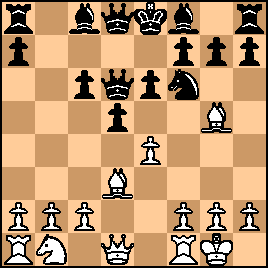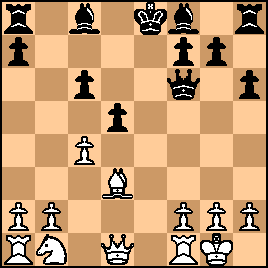| KEG: Alekhine had already clinched first place when he sat down to play this final round game against Daniuszewski (who in turn was entirely out of the running). Though playing the Sicilian, Alekhine decided to avoid wild complications when he declined to capture the White b2 pawn on moves 10 and 11. Later on, Alekhine decided to mix it up, and it appeared that he was headed for an ending a pawn down. But Alekhine likely had it all figured out and reduced to an ending in which--though indeed a pawn down--he had a book draw. This all added up to a short day at the office for Alekhine here, which was probably what he wanted after what had for the first 11 or so rounds had been a close, tough tournament. Sad to relate, this proved to be Alekhine's only appearance in a USSR Championship. Boguljubow returned to play and win the 3rd and 4th USSR championships, and later Botvinnik became top Soviet gun. It would, however, have been thrilling to have had Alekhine compete in one of the USSR championships in which Botvinnik was a contestant. Perhaps even worse, Alekhine sat out (more probably HAD to sit out) the great Moscow 1925 tournament which Bogoljubow won over Lasker and Capablanca. All in all, a sad political story. But at least we got to see some exciting Alekhine games in this 1920 championship USSR tournament. 1. e4 c5
Thus far, Alekhine seemed poised for a fight.
2. Nf3 e6
3. d4 cxd4
4. Nxd4 Nf6
5. Bd3 Nc6
6. NxN
Thus exchanging was probably good strategy against a tactical wizard such as Alekhine. 6... bxN
Both this and 6...dxN have their points. The text as of the time of this game had been played 3 times by Maroczy (yielding him two wins against weak opposition and a draw against Walbrodt at Vienna 1898). Alekhine's move was later played by Bogoljubow at New York 1924 in a game against Emmanuel Lasker in a game won by the latter. 7. 0-0 d5
Maroczy's move in his three above-mentioned games. Bogoljubow played 7...Be7. The text seems clearly best. 8. Bg5

click for larger viewA novelty at the time. Velimirovic later revived the idea in 1968 and 1971, winning both games. 8. Nc3 or 8. Qe2 look simpler and probably better. Perhaps White thought the text would be the best chance to exchange pieces and get a draw against Alekhine who had little to play for having already clinched the title. Alekhine initially selected the safest line against White's novelty. 8... h6
9. BxN QxB
10. exd5

click for larger viewSuddenly, Alekhine had a chance to nab the b2 pawn. 10... exd5
Alekhine's judgment here was surely correct. If 10...Qxb2, White gets much the better game after 11. dxe6 Bxe6 (not 11...QxR? 12. Qf3 and Black gets slaughtered) 12. Qf3 Qb7 13. Nd2. Also inferior for Black was 10...cxd5 11. Bb5+
11. c4

click for larger viewNow Alekhine had to decide if he should venture 11...Qxb2. The move looks OK for Black (12. Nd2 Bd6 13. cxd5 cxd5 14. Qa4+ Bd7 with a slight edge for Black). But, since he had an entirely safe alternative and had no reason to press for a win, Alekhine chose the prudent course: 11... dxc4
12. Bxc4 Be7
13. Nc3 0-0
14. Qe2 Rb8
15. Rfe1

click for larger viewAlekhine had a weak c-pawn but had the two Bishops. Chances were about equal. So how should Alekhine proceed? He could, of course, have played something like 15...Bf5 or 15...Bd8 and probably drawn with minimal difficulty. But Alekhine sometimes seemed incapable of playing uninteresting chess, and beginning in this position he injected major tension into the contest. His choice, as I will discuss in my next post on this game, was probably not objectively best. But I doubt this bothered Alekhine much. He had a sharp playable line, and... | 




